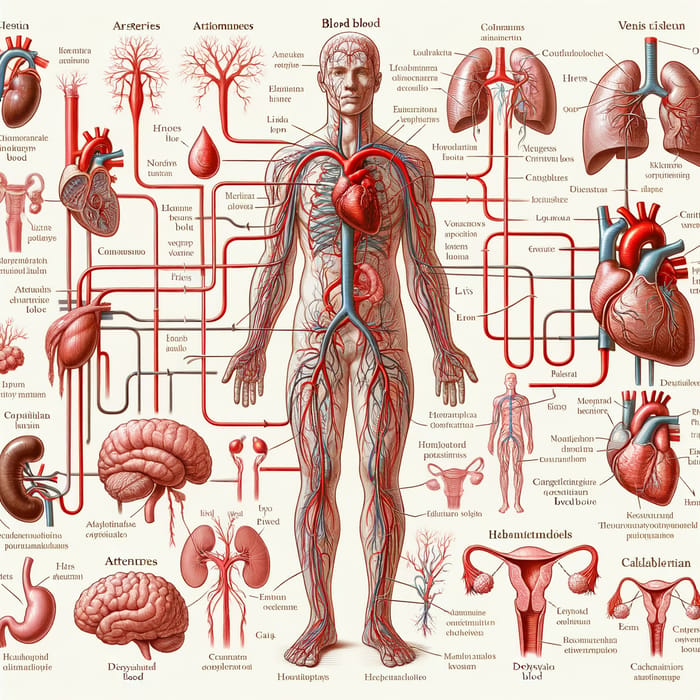Human Circulatory System Organs Diagram And Its Functions

Human Circulatory System Organs Diagram And Its Functions Human Circulatory System Organ systems are groups of organs that collaborate to perform broad biological functions. the human body has 11 major organ systems: circulatory system: includes the heart and blood vessels, transporting blood, oxygen, and nutrients. respiratory system: composed of the lungs and airways, facilitating oxygen intake and carbon dioxide removal. The human circulatory system consists of a network of arteries, veins, and capillaries, with the heart pumping blood through it. its primary role is to provide essential nutrients, minerals, and hormones to various parts of the body.

Human Circulatory System Organs Diagram And Its Functions Otosection What is the circulatory system’s function? your circulatory system’s three basic functions are: move blood throughout your body. bring oxygen and nutrients to your organs, muscles and tissues. remove waste products like carbon dioxide and your organs’ chemical byproducts. The main function of the circulatory (or cardiovascular) system is to deliver oxygen to the body tissues, whilst simultaneously removing carbon dioxide produced by metabolism. The diagram is labeled with the main parts of the cardiovascular system: the heart, arteries, capillaries, and veins. the heart is a fist sized organ in the chest that is responsible for pumping blood. it has four chambers: two upper chambers (atria) and two lower chambers (ventricles). There are four major organs present in the circulatory system. these organs have specific roles and functions as mentioned below. it is located slight towards the left in the thoracic region. the heart is enveloped by the pericardium. the human heart is separated into four chambers.

Human Circulatory System Organs Diagram And Its Functions Atelier Yuwa Ciao Jp The diagram is labeled with the main parts of the cardiovascular system: the heart, arteries, capillaries, and veins. the heart is a fist sized organ in the chest that is responsible for pumping blood. it has four chambers: two upper chambers (atria) and two lower chambers (ventricles). There are four major organs present in the circulatory system. these organs have specific roles and functions as mentioned below. it is located slight towards the left in the thoracic region. the heart is enveloped by the pericardium. the human heart is separated into four chambers. The circulatory system performs four primary functions: transporting oxygen, nutrients, hormones, and waste products throughout the body; regulating body temperature; fighting infections; and maintaining ph balance. The human circulatory system, also known as the cardiovascular system, is a complex network of the heart, blood, and blood vessels. this system plays a crucial role in delivering oxygen, nutrients, and hormones to various parts of the body, and in removing waste products. In the circulatory system, the heart acts as a pump to push out blood. the arteries, veins, and capillaries act as pipes (or tubes) through which the blood flows. these tubes which carry blood are called blood vessels. thus, there are three types of blood vessels in the human body: arteries, veins, and capillaries. This detailed infographic illustrates the relationship between the heart and various organs, showing both venous and arterial circulation pathways, along with the vital role of cardiac muscle in blood circulation.

Human Circulatory System And Organs Illustrated Ai Art Generator Easy Peasy Ai The circulatory system performs four primary functions: transporting oxygen, nutrients, hormones, and waste products throughout the body; regulating body temperature; fighting infections; and maintaining ph balance. The human circulatory system, also known as the cardiovascular system, is a complex network of the heart, blood, and blood vessels. this system plays a crucial role in delivering oxygen, nutrients, and hormones to various parts of the body, and in removing waste products. In the circulatory system, the heart acts as a pump to push out blood. the arteries, veins, and capillaries act as pipes (or tubes) through which the blood flows. these tubes which carry blood are called blood vessels. thus, there are three types of blood vessels in the human body: arteries, veins, and capillaries. This detailed infographic illustrates the relationship between the heart and various organs, showing both venous and arterial circulation pathways, along with the vital role of cardiac muscle in blood circulation.

Diagram Of Human Circulatory System Diagram Quizlet In the circulatory system, the heart acts as a pump to push out blood. the arteries, veins, and capillaries act as pipes (or tubes) through which the blood flows. these tubes which carry blood are called blood vessels. thus, there are three types of blood vessels in the human body: arteries, veins, and capillaries. This detailed infographic illustrates the relationship between the heart and various organs, showing both venous and arterial circulation pathways, along with the vital role of cardiac muscle in blood circulation.

Comments are closed.